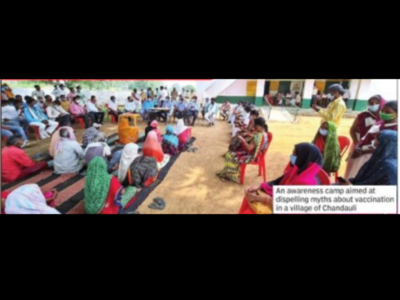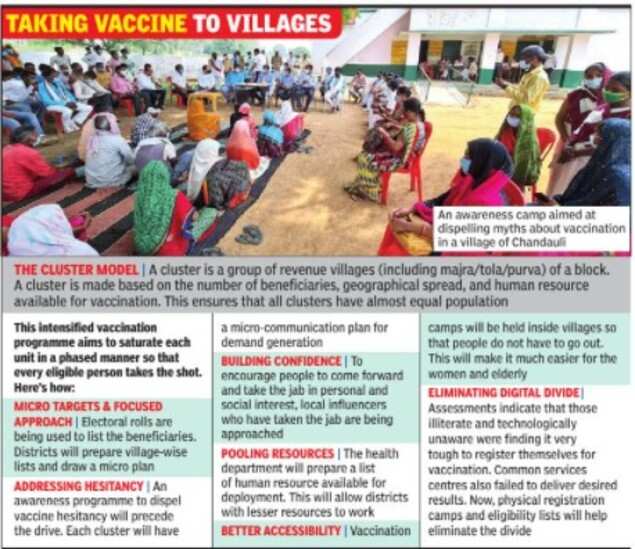- News
- City News
- lucknow News
- Uttar Pradesh’s Cluster Model promises ease of vaccination in villages
Uttar Pradesh’s Cluster Model promises ease of vaccination in villages

An awareness camp aimed at dispelling myths about vaccination in a village of Chandauli
LUCKNOW: There is no doubt that it is a humongous task to vaccinate 13.6 crore people, especially when more than 50% of them live in villages. That’s the target Uttar Pradesh is chasing in its battle against the pandemic virus. The progress so far shows that the state has to walk miles before the target is achieved.
According to data from the CoWin portal, 2.46 crore doses of the Covid-19 vaccine have been administered in UP since the launch of the programme in January. In terms of population, 2.06 crore people in the state have got at least one dose. This translates to about 15% achievement.

However, if the target of herd immunity is to be achieved, the number of fully immunised persons has to be increased. So far, about 40 lakh people, living in cities and peri-urban areas of the state, have taken the two doses. This is barely 3% of the target on board.
Incidentally, less than 40% of these people belong to rural UP. Internal assessments indicated that villages are especially laggard in this race against the pandemic virus and also time. To note, with the current pace of progress—of about 4 lakh vaccinations per day—UP will not be able to vaccinate its total target population by December 2021.
As a result, chief minister Yogi Adityanath wants that 10-12 lakh people are covered daily from July. In the wake of the challenge, the Uttar Pradesh government has tweaked its strategy and adopted the cluster model of vaccination.
“The beauty of this model is that instead of waiting for the people to come forward for vaccination, it will be calling out to the eligible persons on its own. This (strategy) has worked very well with UP on several counts, especially in polio eradication,” explained additional chief secretary, information, Navneet Sehgal.
Besides, the model promises a certain ‘ease of vaccination’ which is a much needed force multiplier in case of villages. Two key elements integrated in the strategy will deliver this promise. The camps will now be held inside the villages instead of near them—even primary and community health centres are 15-30 kilometres away from many villages.
The second key advantage is that it eliminates the step of registration for vaccination through line listing of the eligible persons like for electoral rolls. This helps eliminate the digital divide which had been a deterrent in villages.
“While hesitancy surely prevents people from trying a new thing, logistical issues like distance from home to the vaccination centre, dependency on someone to transport women or elderly to the centre, lack of sources to clear doubts, etc, are crucial contributors,” explained a health department officer engaged in the vaccination programme.
The massiveness of the exercise may be gauged from the fact that UP is home to 97,000 villages. Therefore, a dry run of the actual plan began in four blocks of selected districts to study possible teething troubles and weed out glitches.
Regular features like arrangements to address adverse event following immunisation in the form of quick response teams and deployment of advanced life support ambulances for transportation in case of crisis have been made.
Sources in the Union ministry of health and family welfare shared that the model has already become a talking point in official quarters. The state government has also made presentations on the cluster model before Niti Aayog and government of India officials. Experts are of the view that the model will be a game-changer and it will be picked by other states soon.
According to data from the CoWin portal, 2.46 crore doses of the Covid-19 vaccine have been administered in UP since the launch of the programme in January. In terms of population, 2.06 crore people in the state have got at least one dose. This translates to about 15% achievement.

However, if the target of herd immunity is to be achieved, the number of fully immunised persons has to be increased. So far, about 40 lakh people, living in cities and peri-urban areas of the state, have taken the two doses. This is barely 3% of the target on board.
Incidentally, less than 40% of these people belong to rural UP. Internal assessments indicated that villages are especially laggard in this race against the pandemic virus and also time. To note, with the current pace of progress—of about 4 lakh vaccinations per day—UP will not be able to vaccinate its total target population by December 2021.
As a result, chief minister Yogi Adityanath wants that 10-12 lakh people are covered daily from July. In the wake of the challenge, the Uttar Pradesh government has tweaked its strategy and adopted the cluster model of vaccination.
“The beauty of this model is that instead of waiting for the people to come forward for vaccination, it will be calling out to the eligible persons on its own. This (strategy) has worked very well with UP on several counts, especially in polio eradication,” explained additional chief secretary, information, Navneet Sehgal.
Besides, the model promises a certain ‘ease of vaccination’ which is a much needed force multiplier in case of villages. Two key elements integrated in the strategy will deliver this promise. The camps will now be held inside the villages instead of near them—even primary and community health centres are 15-30 kilometres away from many villages.
The second key advantage is that it eliminates the step of registration for vaccination through line listing of the eligible persons like for electoral rolls. This helps eliminate the digital divide which had been a deterrent in villages.
“While hesitancy surely prevents people from trying a new thing, logistical issues like distance from home to the vaccination centre, dependency on someone to transport women or elderly to the centre, lack of sources to clear doubts, etc, are crucial contributors,” explained a health department officer engaged in the vaccination programme.
The massiveness of the exercise may be gauged from the fact that UP is home to 97,000 villages. Therefore, a dry run of the actual plan began in four blocks of selected districts to study possible teething troubles and weed out glitches.
Regular features like arrangements to address adverse event following immunisation in the form of quick response teams and deployment of advanced life support ambulances for transportation in case of crisis have been made.
Sources in the Union ministry of health and family welfare shared that the model has already become a talking point in official quarters. The state government has also made presentations on the cluster model before Niti Aayog and government of India officials. Experts are of the view that the model will be a game-changer and it will be picked by other states soon.
FacebookTwitterLinkedinEMail
Start a Conversation
end of article
Quick Links
Delhi Air PollutionDelhi TemperatureChennai WeatherBangalore TemperatureCovid vaccination centres in DelhiCoronavirus in DelhiRTPCR test in GurgaonHyderabad RainPollution level in BangaloreDelhi SmogDelhi TemperatureNoida AQIGurgaon AQI todayFire in MumbaiMumbai RainsCovid 19 RT PCR Test in NoidaDelhi AQI todaySrinagar encounter
